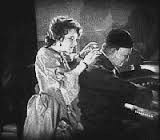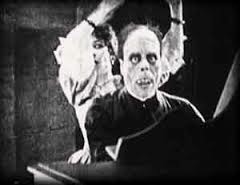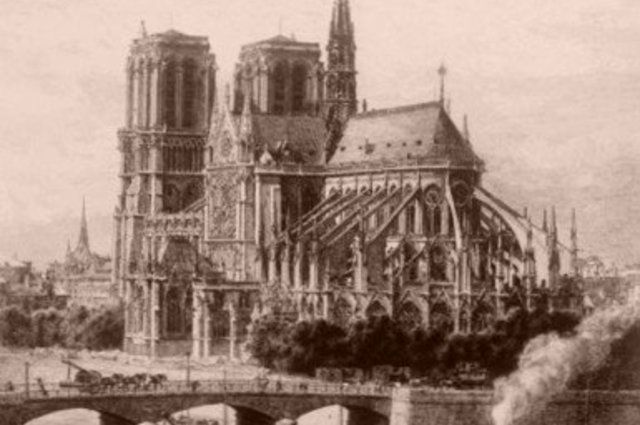THE CLASSIC HORROR FILM
By Jeffrey-Baptiste Tarlofsky
By Jeffrey-Baptiste Tarlofsky
Lesson 3 consists of six sections.
In each section, (1) first watch the video lecture, (2) next read the transcript of the lecture (3), then watch the film excerpt. Repeat for each section. For example, in section 2, watch video lecture part 2, next read the transcript for video lecture part 2, then watch film excerpt #2.
レッスン3は6つのセクションから構成されています。各セッションでは、以下の順番で授業を受けてください。
(1) ビデオレクチャー(動画)を見てください。 (2) レクチャーのテキストを読んでください。(3) 動画(Phantom of the Opera excerpt #1(セクション1の場合))を見てください各セクションで上記のステップ(1)から(3)を繰り返してください。
Directed by: Rupert Julian
Produced by: Carl Laemmle
Based on: The Phantom of the Opera by Gaston Leroux
Starring: Lon Chaney and Mary Philbin
Distributed by: Universal Pictures
Running time: 107 minutes (1925 original release)
Budget: $1,500,000
Earnings in first release: $2,000,000
Part I After the huge success of The Hunchback of Notre Dame, Carl Laemmle and Irving Thalberg set out to repeat their success. The formula was clear; take a famous novel with a grotesque main characte, have Lon Chaney star as that character, and spend a lot of money on the production. They chose The Phantom of the Opera and the film was to be an even greater success than The Hunchback of Notre Dame. The Phantom of the Opera was Universal’s most successful film of the 1920s. The Phantom of the Opera would become a model for the many horror films Universal Studios would produce later in the 1930s. Although The Hunchback of Notre Dame had been an important and successful film and Quasimodo was certainly one of Chaney’s greatest characters, it was not really a horror film. The film lacks those elements of horror which The Phantom of The Opera so clearly has. Although the term “horror film” had not even been invented yet, audiences went to The Phantom of the Opera to be terrified, shocked and filled with dread by Lon Chaney. He did not disappoint them.
In 1925 Phantom of the Opera was something new and the film truly had the power to frighten people. My favorite story is about the day Chaney finished his phantom make-up. Chaney was extremely secretive and would not let anyone see him work on the make-up. On the day Chaney finished creating Erick’s face the writer and director of the film came up with some changes in one scene. They wanted Chaney’s approval before finalizing these changes so they called for a “script girl” to bring Chaney their written changes. A “script girl” is someone (obviously a young woman) in charge of keeping the scripts in order and making sure everyone has an up to date copy. This girl trotted off to deliver the changes to Chaney’s dressing room which was located in the basement of the building where they were working. Just as she started down the long corridor to the dressing room, Chaney was putting the finishing touches on Erik’s face. Satisfied at last, Chaney left his dressing room to go show the Director and crew his creation. The script girl saw Chaney come out of the dressing room and said “Mr. Chaney, I have some papers for you…” and without thinking Chaney turned around and walked toward her to take them. She saw him coming towards her …and she fainted. Chaney quickly rushed to her aid and took her hand and asked her if she was alright…and when she regained consciousness and saw his face…she fainted again! It is a wonderful story, though probably not true. Erick’s face was disturbing! The stories people told of audience members running out of the theater are probably true. In 1925 make-up like Chaney’s was so new that seeing it was an intense experience for film audiences. People really had never seen anything like it before. It was both horrible and realistic. Of course, the phantom does not frighten us very much today because we have seen so many other monsters in the years since. Nevertheless, Chaney’s phantom is still disturbing and this depends as much on his performance as the make-up. We are now going to see where Chaney goes with his performance as we once again look at the scene of the Phantom’s unmasking.

Erik’s face has remained safely hidden behind a mask until Christine allows her curiosity (and ours) to get the best of her. Because she has unmasked him from behind the audience sees Erik’s face before she does, allowing us to enjoy both seeing Erik and a second or so later Christine’s reaction to seeing Erik

Part II The Phantom is classic Chaney. One moment he horrifies us and in the next he evokes our pity. Just as we think he might actually kill Christine, he turns away and starts to weep. He is weeping because she has seen his deformity. Other films which were based on the same novel change the story in a very significant way. In these other films Erik is a handsome young composer whose rival steals his music and then throws acid in his face leaving him horribly disfigured. But, the 1925 film follows the novel. In the novel Erik was born deformed just as Quasimodo was. Erik’s parents abandon him and he grows up institutionalized. He would have been given food and clothing and even an education, but can you imagine anyone picking him up and hugging or kissing him? His own natural parents rejected him because of his deformities. Erik spent his entire childhood without the love and human touch that is essential for normal human development. We can understand why a child denied all human touch would grow up to despise humanity. Like Quasimodo, Erik’s appearance has cut him off from the rest of mankind, but unlike Quasimodo Erik is not mentally handicapped. Far from it, Erik is both a musical and criminal genius. He lurks in the deepest and darkest place he can find, the old dungeons beneath the Paris Opera, but when he sees Christine and hears her sing he is moved by her. Really, it is probably only his desperate loneliness and need for love that makes him believe that if Christine will love him, he can stop being the Phantom. He believes that if she loves him he will be “cured”.
But why would she ever love him? Erik isn’t stupid. he knows he has to offer her something she wants. He will give her the gift of his music and also make her the star of the Paris Opera. In return she must become his slave and love him. Do you see the problem with this? Pause the lecture for a moment and think about it.
It is possible to turn someone into a slave. You can make a slave work for you and you can even force a slave to have sexual relations with you. You can certainly make a slave hate you…but you cannot force a slave to love you. Love is, by its very nature, something someone gives another person freely. Every poet and every artist knows the one great truth about love: You can love someone, but you can’t make them love you back. Erik is just being foolish in thinking he can force Christine to love him. He says he will permit her to sing one time as the star of the opera thus keeping his promise to her, but he forbids her from seeing her lover ever again. She swears that she will obey him. Before we go on, pause the lecture and ask yourself the question: will Christine keep her promise?
Of course not ! As soon as Erik releases her she sends a letter to her lover, Raul, saying that she must meet him at the Masked Ball at the Opera that very night. Watch what happens when she meets her lover, Raul.
Part III Christine and Raul find each other and as they are about to have a private talk, Erik appears at the party as the “Red Death”. That is not only a remarkable costume, but it really is red…in a black and white movie. Before the technology of filming in color was available some films were hand painted to add color. This was an incredibly labor-intensive process, but as you can see the effect could be very dramatic. But it is Chaney’s performance that is most remarkable. His body language and gestures communicate perfectly. We see that Christine’s lover, Raul, is tall and handsome and a brave young man …and incredibly stupid! Because, when Raul hears Erik’s voice he says “I know that voice” and removes his own mask revealing himself to Erik who looks directly at him sees him standing next to Christine. His hand gesture is chilling. Raul wants to stay and fight Erik, but this would be a very unwise thing to do since the Phantom is like a ninja, a master of many weapons and tricks, his favorite of which is the strangler’s cord. Instead, Christine takes Raul to the roof of the Opera. Let’s continue watching.
Part IV Christine tells Raul that she has seen Erik’s face and that he is a loathsome monster (あたしすごいかわいそう!). Not only has she broken her promise not to see Raul, but Christine also has a clever plan to betray Erik by first performing as the star of the Paris Opera and then escaping to England with Raul. The only problem with this plan is that Erik has heard every word of it. In the next two excerpts her plans don’t go quite as she expected.
Part V Once again Christine finds herself in Erik’s underground lair and this time he has no intention of ever letting her escape. Remember what Erik wants and why: he wants Christine to love him because he believes that if he is loved he can stop being the Phantom, stop being evil. He even says that it is the evil inside him that has made his face ghastly. Of course he has it exactly wrong. It is the fact that he was born deformed that made other people reject him and it is this rejection that has made him become the Phantom. Sometimes he seems to understand this and sometimes he doesn’t. But what he truly believes is that if Christine will love him he can stop being evil. This is interesting from both a psychological and a philosophical perspective. Something psychologists and philosophers disagree about is the question of whether individuals are ultimately responsible for their own actions. The philosophers believe individuals might choose to be evil but that this is always a choice. On the other hand, the psychologists would say that sometimes people cannot be held responsible for their actions because they are insane. Erik certainly does many evil things. He kills many people in the film, but is he responsible for his actions? It is a question we will return to many times as we watch other horror films.
Gaston Leroux’s novel differs from the film in having a relatively happy ending. In Leroux’s novel Christine does not actually try to cheat Erik, she simply wants to escape from him. When she is kidnapped a second time Erik threatens to kill Raul unless she does as he commands. Christine agrees to this, but at this point the novel and the Chaney film take radically different directions. In the novel Christine hears Erik explain that his own mother never kissed him or held him as a child. She is overwhelmed with pity and she kisses him on the forehead.
This, of course, is not a lover’s kiss, it is the kind of kiss a mother gives a young child. The kiss is transformational. The effect is exactly as Erik hoped it would be, he allows both Christine and Raul to leave. Lon Chaney thought the novel’s ending was too sentimental. In his film Christine has essentially made a devil’s bargain. She sold her soul to Erik in return for being made the star of the Paris Opera. When the “Devil” wants his payment, she tries to escape. In most such stories the person who sold themselves for gain is the main character and must eventually accept their fate. But in Chaney’s film he is the main character and the tragedy is his, not Christine’s. In the film there is no kiss for him, Christine completely rejects him. When Erik’s hiding place is discovered he steals the coach Christine and Raul planned to escape in and tries to get away with Christine inside. Let us watch the final scenes of the film.
Part VI Just one note about the production: did you notice that Erik runs right past Notre Dame Cathedral! The set was still standing in 1925 and Universal figured “motainai” and so Erik runs past the cathedral as he makes his way down to the Seine river. Actually, the Opera Garnier and Notre Dame are quite far from each other, but you wouldn’t know that unless you knew Paris. Of course the first time I saw Paris I had to see both these places since they appear in these famous horror films.
When the mob catches Erik they violently beat him and drown him. But, we get a sense that Erik was already doomed when Christine rejected him for the last time. He had no hope for her love and thus no hope for the transformation he believed her love could bring him. He was doomed. Just as any sort of true romance between Quasimodo and Esmerelda would have been impossible in The Hunchback of Notre Dame, so too was any romance between Erik and Christine in The Phantom of the Opera. In both films the “monster” was doomed because the woman he loved could never return that love. That is classic Chaney. Although Quasimodo and Erik are opposites in many ways; one good, the other evil, Quasimodo dying while protecting Esmerelda, Erik dying while trying to kidnap Christine, there is still a sort of basic rule about what happens to the monsters in these films. The monster dies in the end.
This concludes lecture #3
